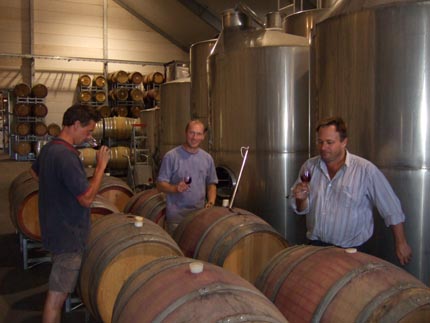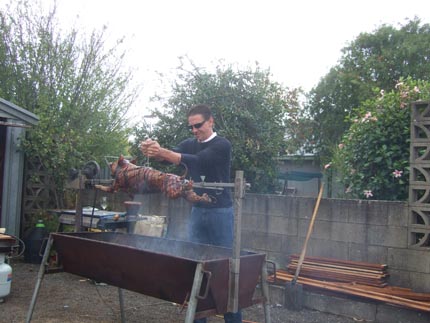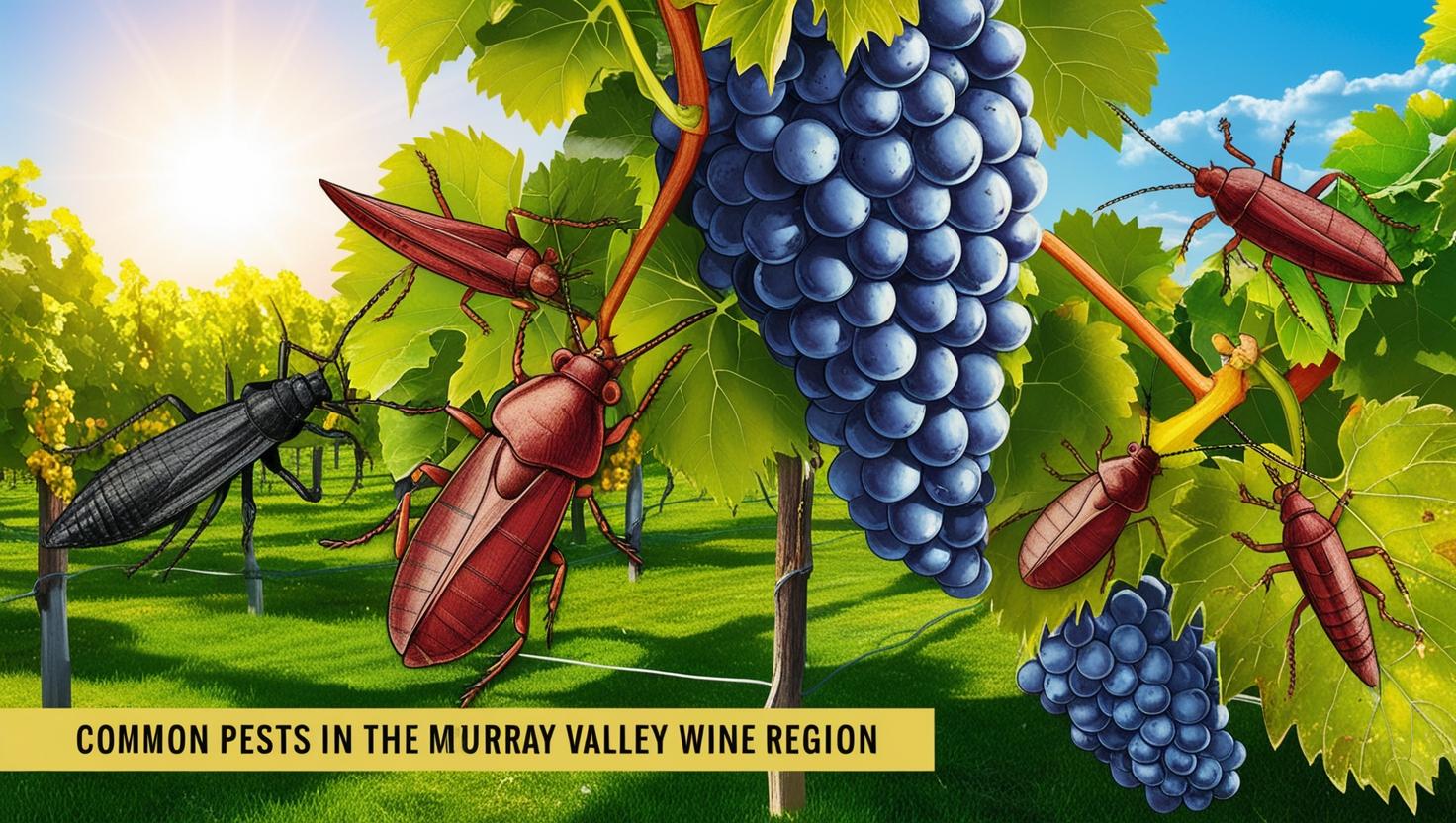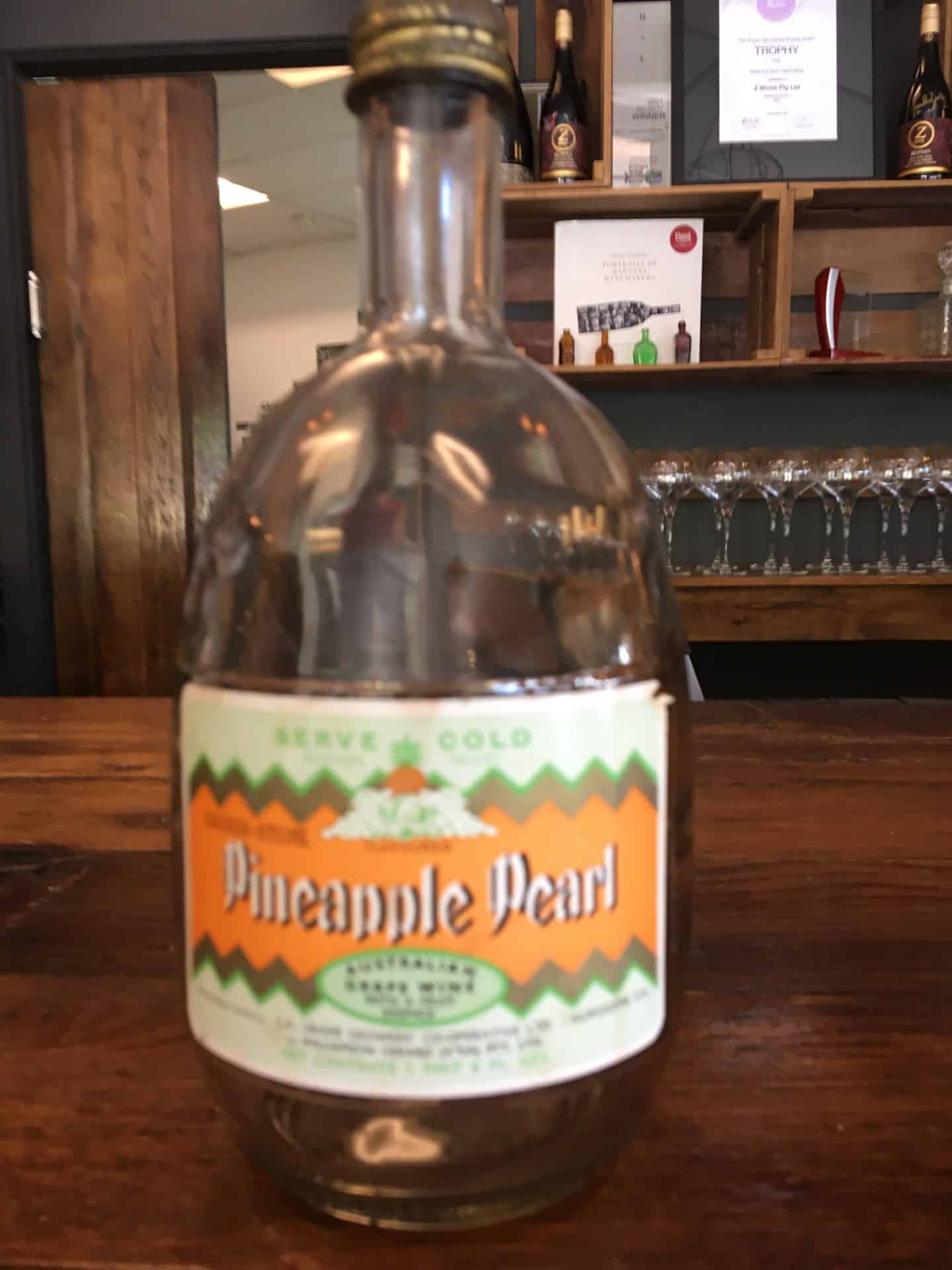Barossa Mataro was one of the first varieties planted in South Australia and from the 1880s was a staple in the production of fortified wines. The period from the 1890s till the 1950s spans the dark ages for table wine in Australia and the choice was beer, spirits, sherry and port. As the consumption of table wine grew from 1950, mataro was not included and as recently as the mid 1980s growers in South Australia sacrificed it as the least worthy variety in a government ‘vine pull’ scheme.
During its long years as a fortified component mataro developed a reputation as being an easy variety to grow and was often the last picked. In the days of fortified wine when the grower was rewarded by tonnage and sugar content that made little difference. Somewhere though in this past history mataro developed a reputation as a rubbish variety for table wine.
While the ‘Mataro Awakening’ is underway even now mataro has only a small following and is regrettably about the last variety an informed red drinker would ask for.
I wondered if the poor image of mataro had anything to do with it being the last variety picked so I asked the winemaker Tim Smith for his thoughts.
“Vintage is a very hectic time with excessively long hours and after so much work is pushed into such a short time it is only natural to think of the finish and having a break. And this could happen sooner if it wasn’t for the bloody mataro which just hangs and hangs and is always a week away from picking”. Tim was non committal about the thought that wine makers had lost interest by the time mataro was ready though he did relate how one grower would take a break and go for a week’s fishing before heading back for the picking.
Mataro ripens late, meaning it reaches the right sugar content late in the season, or to be far more exact the point wine makers call phenological ripeness. This is the moment when the fruit is sweet, the pips and skin are ripe, and the grape stems have loss the edge of green colour. At this stage they are ready for harvest but this window of opportunity is actually quite fine and I was told is shorter for example than shiraz.
Here are the thoughts of four winemakers who approach mataro with a slightly different visions though they are driven by the same desire to prove that Barossa mataro is a remarkable variety deserving premium recognition.
Rolf Binder of Veritas-Rolf Binder Wines.
Rolf was born to be a winemaker and as the family vineyard holdings included important mataro vineyards he knew his aspirations and destiny would involve this variety. Indeed over the last decade Rolf has spoken extensively across the globe about the glories of Barossa mataro.
Rolf found mataro was a mystery book though he knew it had great secrets to reveal and perhaps more than any other Barossa maker is identified with mataro. The variety was liked by his father who began making blends with mataro in the early 1960s and in 1967 made the first Veritas Bulls Blood Shiraz Mataro. One of the family treasures is a block of bush vine mataro behind the winery that is over 85 years old. Rolf recalls learning the craft of pruning these vines beginning in 1978.
It was Rolf who tutored me in mataro which he did over numerous bottles, during extensive masked tastings and by giving me the chance to participate in numerous barrel tastings. I can recall his words; “can you feel those slippery tannins yet!” I also realised that it had taken Rolf all his winemaking life to discover the hidden secrets of this unloved variety or as he reminded me 33 vintages. I treasure the times over many years talking to Rolf about mataro and have enjoyed many of his famous Bulls Blood blend and numerous other rare experimental wines.
To the grower he says they must show patience and the vine may take 15 years before it begins to reward with fully ripe, even bunches and steady crops. As with all varieties there is a moment when it is time to pick and this is often when the winery is strangely silent as the other varieties have all been harvested.
For Rolf the beauty of mataro is found with its tannin structure as this is what makes it great and as he says; ‘it tames shiraz’. He confirms this by mentioning numerous winemakers and wines that have it as a background ingredient, the secret of the Barossa both in reds and fortifieds.
Again and again during discussions Rolf would return to the structure and shape of mataro tannins, their bright crisp tones which were made to lift the duller tannins of other varieties. While the flavour profile of mataro can be a little lean, at times even mean, for Rolf all is forgiven by the structure mataro gives to a wine. And all of this is because the Barossa warmth delivers the ripe tannins and not the green tannins which mar the variety in other regions.
No other winemakers interviewed talked about the match of wine and food with the passion of Rolf. When thinking of food and mataro he refers to a cuisine of 50 years ago as being the best for mataro when food was not as sweet as today; and feels that high tannin varieties like mataro and nebbiolo have suffered with the demise of traditional French cuisine.[A recent Bandol I tried brought these words right home to me] For Rolf mataro is an intellectual variety that does not fit easily with many foods.
In the winery he considers great skill is needed as flavours can build quickly during fermentation and while it needs heat for fermentation this must not be overdone. It is not a variety for a new winemaker to be given and because of the intimacy required in the winery it is not done well by large companies with their system controls and haste to finish the harvest. [This point was made by the other winemakers] Rolf talks about how mataro must be shown respect and uses terms like ‘it’s not an easy friend’ and how you must show emotion to discover the best of mataro.
For Rolf mataro is a great friend to have being a brilliant, hot climate variety and is the hidden ingredient in many warm climate reds but believes its time we saw it in full light as a varietal and enjoyed its subtle flavours. To wrap up he mentioned that globally only Spain and the Barossa do this variety well.

Vintage 2007 Rolf Binder winery with Rolf on the right and Kym Teusner on the left.
Peter Schell (Spinifex Wines)
Pete to me approaches wine making from a different direction and I find him one of the deep thinkers of the new wave of Barossa winemakers. He queries every process seeking another angle or at least questioning why it is done this way and looks for the edge which will display another facet of a variety. He seeks and finds a detail to polish that eludes other makers and while he understands that the Barossa warmth means ripeness and alcohol he finesses what is given into a gentler expression of the Barossa.
I do not think the Barossa is about elegance but Pete moves closer to this than others wish or perhaps want. One feature is the use of old oak or no oak at all and slowly he has built a collection of very large old French oak vats which are used for fermentation and storage and he persists with these despite the enormous hygiene problems they create.
The elegance of the wines comes from the detail in the making and his wines show a polish I have seldom seen in Barossa reds and somehow he has opened a layer of delicacy, fragrance and softness in wines not revealed by others and the term he uses is finding the ‘feminine’ side. When this is applied to mataro the results are most interesting and you find in these wines aromas not emphasised by others. The palate of these wines is also very long.
I must make the point before the low alcohol brigade warms up that he picks when the grapes are fully ripe and I doubt if he cares what the alcohol is as balance is all. In this regard he reminds me of another great Barossa maker Chris Ringland who makes a 16% shiraz seem like it is 12.5%.
Tim Smith (Tim Smith Wines)
Tim is a master craftsman and in my view approaches winemaker in the manner of a furniture maker from the 18th Century. I find him fascinated with the detail, the structure, and the intricate joinery of a wine and this is expressed in his wines with a firmness and length different to other winemakers. Tim I think starts with a detailed picture of what can be achieved and uses fine chisel to accentuate the structure of the wine, or its line and length as show judges call this feature.
Tim captures beautifully one of the aroma nuances of mataro by describing it as ‘the aroma of China town on a warm night and particularly that of Peking duck’ and over the few chats I have had with him returns again and again to descriptors like Chinese five spice, Asian aromas, and particularly the aroma of Kirsch, the eau-de-vie made from cherries. [Rolf Binder also describes the aromas of mataro in a wonderful manner]
Like all the winemakers who work with this variety he finds appeal in the structure of the tannins as this is the special feature of the variety and why it adds so much to blends. Tim made the point several times that mataro is a complicated variety and requires a specialist to bring out the best while suggesting it has not been given the respect needed. [To which I might add until consumers understand the amazing merits of mataro few winemakers will want to put the effort into bringing out its best.]
The popular thought may be that it can be picked any time after the others but he has found this is not so and the picking time while late in the season can be as brief as one week and is identified by a strange fluorescence to the grape juice- a remark others also made to me.
Tim Smith told me stories about how he is slowly coaxing his growers towards making premium mataro for the table wine market, with some success. He tells them not to relax, the season is not over until the mataro has been harvested in optimum condition and it is worth the effort.
Tim has the time and intellect to make great mataro. He knows what it can do and knows it must not be rushed or as he says ‘its a variety for a wine nerd’ and explains that its for those with intellectual curiosity.
Kym Teusner (Teusner Wines)
Watching Kym build his business over the last eight years has been like watching a trapeze artist at work, a bursting confident spectacle though at times you cannot bear to look. I see some of this daring in his approach to winemaking as over the years he has produced a succession of supremely confident styles that burst with fruit and flavour with many of them giving us new insights into a more vibrant, brighter Barossa red wine style.
Of the new wave of dynamo winemakers no one has embraced mataro more emphatically than Kym. He saw quickly that it was the secret holding up interest in many Barossa shiraz’s but delved much deeper to see what it might be like as a single variety. In a blend he talks about mataro as being the nuts and spices that change the smooth sweetness of a chocolate, thus giving intrigue to the wine.
He felt it suffered so much in the 1980s vine pull scheme as it had a bad reputation for making weak insipid wines quite light in colour. The same cannot be said of shiraz which vintage after vintage, fair weather or fowl makes remarkable deeply coloured tasty wines. Thus with money being offered to remove an oversupply of reds the choice made by many Barossa growers was to sacrifice the plot of mataro and we now see in hindsight what a terrible tragedy this was.
Kym feels it’s not a variety the big corporate winemakers have time to understand with one reason being the late harvest means time and money keeping the winery open which helps explain one of the deeper reasons why mataro has sat unloved and forgotten.
The grapes are given a warmer ferment than say shiraz [also mentioned by the others I interviewed] which means the ferment runs faster. Because of this Kym takes the ferment to dryness before pressing this being different for example to shiraz.
In the vineyard he finds the correct picking ripeness is not always indicated by brown seeds nor by hands that get stained by the grape juice meaning its in the winery where the warmer ferment and working the cap takes over more of a roll to extract the colour from the skins and I gained the impression it is a much more delicate and thorough process than working with shiraz for example. [reading my notes I may have this sequence a bit confused]
Kym confirms with others that mataro is a problem variety and it needs skilled hands to unlock the potential.

Mataro neglected
The conclusion seems to be that the neglect of mataro for so long is partly because it’s a late ripening variety and in a valley dominated for so long by big companies was unwanted. The growers and winemakers had lost interest; the wine was seen of poor quality with a weak colour and this added up to a variety with a low market value. No longer having any use as a fortified variety it became the variety which got in the way of the post harvest vintage festival.
Hence mataro became the wall flower varieties, too difficult to worry about, and we must be thankful that many growers did not take the money offered by the vine pull scheme but elected to battle on. Winemakers like Rolf Binder, Chris Ringland and Robert O’Callaghan were working with the variety by the 1980s with great results but even so this was a labour of love with little recognition of the importance of the experiments.
At least the push forward has continued and a new wave of winemakers are building on this small but important legacy and have decided they like what they see and are happy to postpone the after vintage festivities.
In summary it seems to me that the Mataro Awakening now belongs firmly in the hands of adventurous wine drinkers, so over to you Glug customers.





